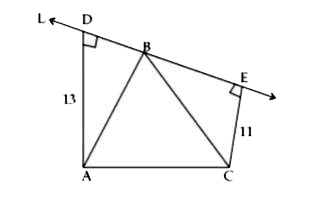The figure shows an equilateral ΔABC with a line L passing through B. AD and CE are perpendicular to L respectively. If AD = 13 and CE = 11 find AC = ?

11
12
13
14
Step by step video & image solution for The figure shows an equilateral DeltaABC with a line L passing through B. AD and CE are perpendicular to L respectively. If AD = 13 and CE = 11 find AC = ? by Maths experts to help you in doubts & scoring excellent marks in Class 14 exams.
Updated on:21/07/2023Topper's Solved these Questions
Similar Questions
Knowledge Check
In a ΔABC, the median AD is perpendicular to AC. If b = 5 and c = 11, then a =
A10B12C14D√221In figure, ABC is a right triangle, right angled at B. AD and CE are the two medians drawn from A and C respectively. If AC = 5 cm and AD=3√52cm, find the length of CE:
 A2 cmB2√5 cmC5√2 cmD3√2 cm
A2 cmB2√5 cmC5√2 cmD3√2 cmIn figure, ABC is a right triangle, right angled at B. AD and CE are the two medians drawn from A and C respectively. If AC = 5 cm and AD=3√52cm, find the length of CE:
 A2√5cmB2.5cmC5cmD4√2cm
A2√5cmB2.5cmC5cmD4√2cm
In the given figure, AD and CE are bisectors of ∠A and ∠C respectively. If ∠ABC90, find ∠ADC+∠AEC
View SolutionAltitude AD of equilateral ΔABC is a diameter of circle O. If the circle intersets A¯¯¯B and AC at E and F, respectively, find the ratio of EF : BC?
View SolutionInternal bisector of ∠A of triangle ABC meets side BC at D. A line drawn through D perpendicular to AD intersects the side AC at E and the side AB at F. If a, b, c represent sides of ΔABC, then
View SolutionIn Figure, AD is a median and BL, CM are perpendiculars drawn from B and C respectively on AD and AD produced. Prove that BL=CM

View SolutionThe area (in square units ) of the triangle formed by y-axis , the straight line L passing through (1,1) and (2,0) and the straight line perpendicular to the line L and passing through (1/2, 0) , is
View Solution
